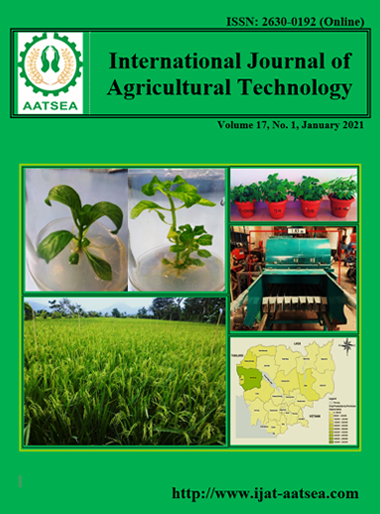Social media adoption and use by public agricultural extension organizations in Thailand
Main Article Content
Abstract
This research explored the adoption and use of social media, i.e., Facebook and YouTube, by district and provincial agricultural extension offices (AEO) under Thailand's Department of Agricultural Extension (DOAE). To this end, 882 district AEO’s and 77 provincial AEO’s websites, as well as Facebook’s and YouTube’s website, were searched. Contents posted and user interactions (i.e., 'Like,' 'Comment,' and 'Share') were collected and analyzed. It was found that 566 district AEO (64.17%) and 65 provincial AEO (84.42%) adopted Facebook. However, there were ten district AEO (1.13%) and nine provincial AEO (11.68%) with full adoption and active use of Facebook. For YouTube, only some disitrct and provincial AEO started to use it, and none were active users. An analysis of the Facebook contents posted by the ten district and nine provincial AEO, who were active users, revealed that most information was theirs, and published mainly with texts and pictures. It was also found that the AEO primarily distributed information concerning the offices’ activities. This type of information may be a reason for lack of user engagement in terms of 'Comment' and 'Share.' Thus, social media adoption and use by district and provincial AEO need to be improved. A policy or directive would be necessitated to encourage the AEO to adopt social media, especially YouTube. Extension officers’ capacity building for effective social media use should be provided. Also required is a clear guideline outlining elements of social media use (for example, management of personnel or team involved, and a procedure for publishing information). It should specify a priority of data to be disseminated, which would also help the AEO to employ Facebook, YouTube, and other social media applications in ways more attractive and beneficial
Article Details

This work is licensed under a Creative Commons Attribution-NonCommercial-NoDerivatives 4.0 International License.
References
Andres, D. and Woodward, J. (2013). Social media handbook for agricultural development practitioners. Washington, DC.: United States Agency for International Development (USAID).
Ayanso, A. and Moyers, D. (2012). The role of social media in the public sector: Opportunities and challenges. In K. Kloby & M. J. D’Agostino (Eds.), Citizen 2.0: Public and governmental interaction through Web 2.0 technologies, (pp.1-22), Hershey, PA: Information Science Reference.
Bonsón, E., Royo, S. and Ratkai, M. (2015). Citizens’ engagement on local governments’ Facebook sites. An empirical analysis: The different media and content types in Western Europe. Government Information Quarterly, 32:52-62.
Bonsón, E., Royo, S. and Ratkai, M. (2017). Facebook practices in western European municipalities: An empirical analysis of activity and citizens engagement. Administration & Society, 49:320-347.
Christoplos, I. (2010). Mobilizing the potential of rural and agricultural extension. Rome: FAO and the Global Forum for Rural Advisory Services.
Cornelisse, S., Hyde, J., Raines, C., Kelley, K., Ollendyke, D. and Remcheck, J. (2011). Entrepreneurial extension conducted via social media. Journal of Extension 49:Article 6TOT1.
Davis, J. and Dishon, K. (2017). Unique approach to creating and implementing a social media strategic plan. Journal of Extension 55:Article v55-4iw1.
Elo, S. and Kyngäs, H. (2008). The qualitative content analysis process. Journal of Advanced Nursing, 62:107-115.
Gunawong, P. (2015). Open government and social media: A focus on transparency. Social Science Computer Review, 33:587-598.
Ibrahim, B., Aljarah, A. and Ababneh, B. (2020). Do social media marketing activities enhance consumer perception of brands? A meta-analytic examination. Journal of Promotion Management, 26:544-568.
Kinsey, J. (2010). Five social media tools for the extension toolbox. Journal of Extension, 48:Article 5TOT7.
Kemp, S. (2015). Digital 2015: Thailand. Available at: https://datareportal.com/reports/digital-2015-thailand (Accessed: 30 April 2020).
Kemp, S. (2020). Digital 2020: Thailand. Available at: https://datareportal.com/reports/digital-2020-thailand (Accessed: 30 April 2020).
Mergel, I. (2017). Social media communication modes in government. In Y.-C. Chen & M. J. Ahn (Eds.), Handbook on information technology in government, (pp.168-179). New York, NY: Routledge.
Newbury, E., Humphreys, L. and Fuess, L. (2014). Over the hurdels: Barriers to social media use in extension offices. Journal of Extension 52:Article v52-5a1
Parsons, M. (2015). Social media tools for the extension toolbox. Journal of Extension 53:Article 2TOT7.
Rogers. E. M. (2003). Diffusion of innovations, 5th ed. New York: Free Press.
Saravanan, R., Schiradipta, B., Chowdhury, A., Hall, K. and Odame, H. H. (2015). Social media for rural advisory services (Note 15). Lindau, Switzerland: Global Forum for Rural Advisory Services (GFRAS).
Stern, E. K. (2017). Crisis management, social media, and smart devices. In Akhgar, B. Stainforth, A. and Waddington, D. (Eds.), Application of social media in crisis management: Advanced sciences and technologies for security applications (pp. 21-33). Cham: Springer International Publising.
Suchiradipta, B. and Saravanan, R. (2016). Social media: Shaping the future of agricultural extension and advisory services. Lindau, Switzerland: Global Forum for Rural Advisory Services (GFRAS).
Thakur, D. and Chander, M. (2018). Use of social media in agricultural extension: Some evidences from India. International Journal of Science, Enviornment and Technology, 7:1334-1346.
Turner, B. (2015). Do your YouTube videos suck? Make them high-quality using these 4 simple tips. Entrepreneur Asia Pacific. Available at: https://www.entrepreneur.com/article/253247 (Accessed: 5 May 2020).
White, C. M. (2012). Social media, crisis communication, and emergency management: Leveraging web 2.0 technologies. Boca Raton: CRC Press.


